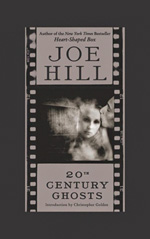
![]() verkisto
verkisto
7/26/2016
![]()
Joe King Hill is a pretty good writer. I mean, he should be, given his lineage. If he didn't pick anything up from a lifetime of being around his father, then he would deserve to be nothing more than a name-dropper. That he's not a name-dropper, and that he has enjoyed some deserved success over the years is an indication that he did, in fact, pick up and/or inherit the skillz necessary to be a successful horror writer. A lot of people will probably pick up his fiction out of curiosity, and I expect that a good many of them will be surprised by what they find. Many of them will come back for more, though, I would expect.
Heart-Shaped Box was a pretty good read, though a bit clunky. A first novel typically is, because writers find that sustaining a plot for longer than their accustomed 10,000 words is trickier than expected. What was impressive about the novel was that his narrative flew, and captured you even when the events it described were a little hard to believe. I won't belabor the point, since you can read that review here on my blog, but let's just say that I was apprehensive, knowing who the author was, but was pleasantly surprised at the outcome.
20th Century Ghosts is a collection of Hill's short stories, most of them published before the novel. (This is actually a trade release of a previously limited edition of the book, with a couple of extra stories included.) Some are weird, others made me wonder what the heck was going on, but most of them were rather impressive. It opens with a story that won't mean much to you unless you follow some of the smaller horror fiction magazines, or have at least tried to break into that market in the past. It's titled "Best New Horror," and is a rather formulaic story about an editor who's tired of formulaic stories. By itself, it's not really that impressive (and it opens with some brutal, misogynistic imagery that might turn many people off of the entire collection), but that second layer of irony makes it a little more interesting. And it's this sense of style, I think, that makes Hill successful.
"You Will Hear the Locust Sing" is Hill's take on Kafka's "The Metamorphosis"; "The Cape" is a revenge story taken above and beyond what you would expect; "Bobby Conroy Comes Back from the Dead" is a touching story of past loves set on the film set of a George Romero zombie movie; "The Black Phone" is that sort of horror story that uses a cliche in a new fashion, and that maintains the right amount of dread and suspense. In short, the stories work, and will surprise you, but the one story that makes this book necessary reading, to me, is "Pop Art."
You have never read anything like "Pop Art." It has a Kafka-esque beginning, where you're introduced to a boy who is an inflatable doll, but like "The Metamorphosis," once you accept that one, incredible point, the rest of the story falls into place. The story is told by Art's best friend, and describes some of the trials and tribulations that go along with being an inflatable boy. It's so much more than that, though. The story is about friendship, growing up, making sacrifices, love, and so much more, and it's all conveyed in the span of 22 pages. I will concede that not all of the stories in this collection will be for everyone, but "Pop Art" is one of those stories that I expect to show up in literature collections in the next 20 years. It's just that distinctive, and just that good.
I would only recommend Heart-Shaped Box to people who can stay with a book despite some issues with the core plot, and I would only recommend 20th Century Ghosts to those who can withstand some gruesome imagery. For anyone who reads for imagery, for prose, and for sheer effect, though, either book is worth reading. Come for the curiosity, but stay for the talent.